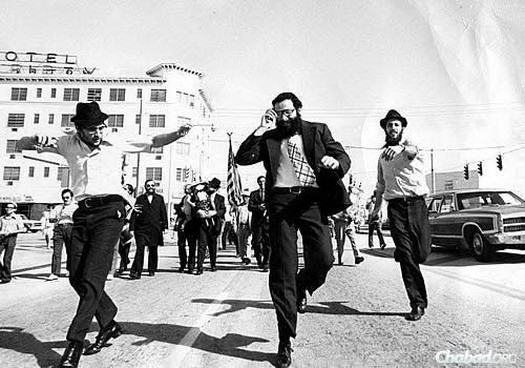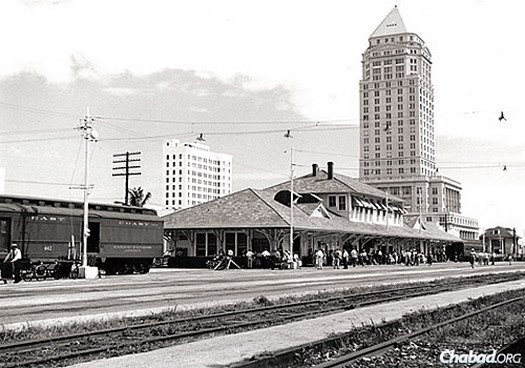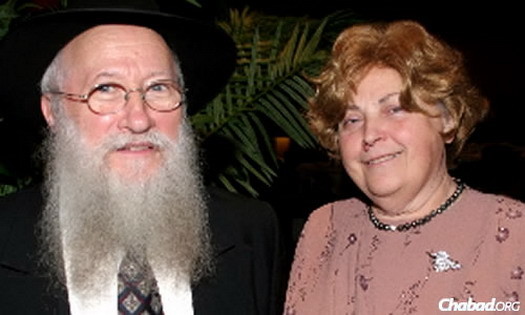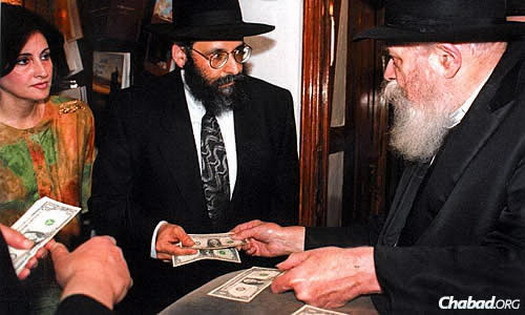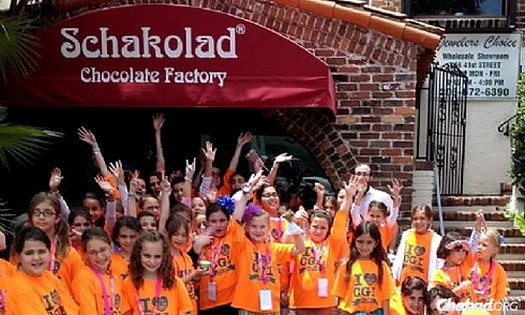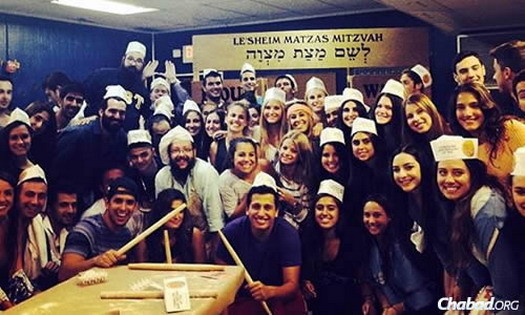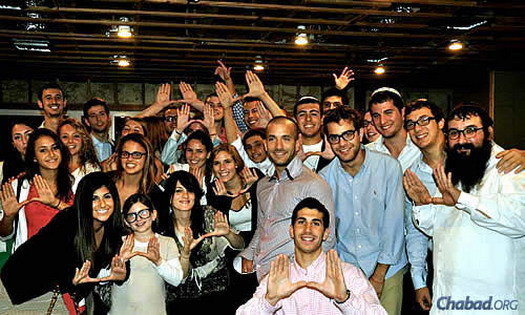
Dramatic Chabad Growth in South Florida Latest Sign of 75-Year ‘American Jewish Revolution’
It has been 75 years since the sixth Lubavitcher Rebbe—Rabbi Yosef Yitzchak Schneersohn, of righteous memory, a refugee from Communist Russia, Nazi Germany and war-torn Europe—arrived on America’s shores in 1940, on 9 Adar, 5700, which corresponds this year to Feb. 28, 2015. And in that time, the Chabad-Lubavitch movement has developed into a vibrant presence in Jewish communities around the nation and the world, with the most dramatic recent growth taking place among young families.
There are few places where this phenomenon has been more documented than in South Florida. According to the recently released “2014 Greater Miami Jewish Federation Population Study: A Portrait of the Miami Jewish Community,” 42 percent of Jewish households with children in Miami-Dade County have engaged with Chabad-Lubavitch programming during the past year and, in the case of an even younger age bracket, 47 percent of those under 35 enjoyed involvement with Chabad over that same time period.
When factoring in all age groups, including seniors, some 26 percent of Jewish households in the area connected with Chabad, according to the study.
“When I saw that number, my jaw dropped,” said Ira Sheskin, director of the Jewish Demography Project of the Sue and Leonard Miller Center for Contemporary Judaic Studies at the University of Miami, and professor and chair of geography there. “I was thinking maybe 10 or 15 percent.”
Among the other findings, the vast majority of attendees—some 75 percent—identified themselves as non-Orthodox.
Sheskin, who has completed 42 major Jewish-community studies for Jewish Federations throughout the country, offered some theories on the reason for the big Chabad numbers. “I think a good part of it is that it’s welcoming, and it’s open to everyone,” he said. Additionally, people feel Chabad is a “very authentic Jewish experience.”
He adds that because Chabad centers don’t charge annual dues, an economic barrier is lifted as well.
This is the first time the once-a-decade report detailed Chabad engagement, according to Michelle Labgold, chief planning officer of the Greater Miami Jewish Federation. The question was broadly worded and covered a range of activities, from attending services and classes at Chabad centers to to joining in a range of holiday programming.
“We’re glad we asked the question,” said Labgold. “What’s striking is the evident reach of Chabad in reaching a part of our population.”
Chabad itself has grown greatly over the years in the Miami-Dade area, Sheskin said, from five centers in 1994 to 23 centers in 2014.
“It’s becoming well-known that Chabad caters to Jews of all backgrounds. For people who are just coming in for the first time or for Jews who are already observant, Chabad offers a welcoming, nonjudgmental environment,” states Rabbi Sholom Lipskar, who was sent to Florida 46 years ago by the Rebbe—Rabbi Menachem M. Schneerson, of righteous memory—and has been living and working in the Miami Beach area ever since.
Three decades ago, he started The Shul of Bal Harbour in Surfside, Fla., a thriving Chabad center that includes programming from infants to seniors. Committed to spreading Judaism far beyond his local area, Lipskar also founded the Aleph Institute, a nonprofit organization that supports Jews in the military and in prisons.
The growth of the Jewish population in the Miami-Dade area has steadily increased since then, and Chabad’s presence has flourished right along with it.
Rabbi Yakov Fellig, co-director of Chabad of South Dade in Miami with his wife, Gutal, since 1989, sees Chabad’s unique combination of openness and steadfast adherence to Jewish tradition as key to its success in Florida and beyond. Today, there are 11 Chabad branches in South Dade, from Key Biscayne to Homestead.
“For years, people tended to look for synagogues, schools and Jewish institutions that reflected their level of observance,” explains Fellig. “In the end, that approach didn’t work.
“What we are seeing today is that young people—though not necessarily observant—are searching and looking for an authentic spiritual experience. They are looking to be connected, looking to be inspired,” he continues, “and Chabad provides them with an uncompromised approach to Judaism, which they love.”
‘Across the American Scene’
For Rabbi Sholom and Chana Lipskar, that kind of success has been based not just on principles, but on programming. The Shul has been reconnecting Jews with Judaism since it opened its doors in 1981 (the same year the Aleph Institute was founded), moving from an apartment building to a storefront to its own $10 million building as membership grew.
As more and more Jewish individuals and families moved south—many from Northeast states like Massachusetts, New York, New Jersey and Pennsylvania—the population expanded and the amenities followed. And so did the list of programs and services offered, including Hebrew school, summer camp, women’s classes, singles’ events and more. While seniors remained central to attendance, a different generation was calling Florida home.
The Lipskars had no problem handling the numbers. For the last 13 years, for example, the rabbi has run a Torah-study class that draws hundreds of participants on Tuesday nights. It’s an impressive number, especially considering that many core members of The Shul come from secular backgrounds.
Within the next two years, the couple has plans to double their space to accommodate the growing community’s needs. The Shul holds five minyans (the quorum of 10 men needed for public prayer) every morning, and five on Shabbat.
The rabbi says it mirrors “the saturation of Chabad across the American geographic scene, which is unprecedented.”
‘The Secret of Success’
Miami today is a radically different place than when Rabbi Avrohom Korf, head shaliach and director of Merkos Lubavitch of Florida in Miami Beach, landed there on Nov. 14, 1960. (He remembers the date exactly.) Born in Russia and a relative newcomer to the United States, he and his wife, Rivka, set about making the place home.
Now 82, he says the story of South Florida—and the success of Chabad in general—can be summed up by an anecdote.
Korf explains that he went to the office building of an older professional who had shown not only disinterest in observant Judaism, but annoyance. He told the receptionist that he would like to speak with the gentleman; that he needed two minutes about something personal. The reply: He was too busy.
So the rabbi waited … and waited.
Finally, he was sent in. Korf took out his tefillin and asked the man to hold out his left hand. “For that, you want to waste my time?” posed the man.
The rabbi replied, “I only asked for two minutes. You already spent 20 minutes” on this.
The man had Korf put on the arm tefillin and the head tefillin, and suddenly, he started to cry. He said he hadn’t seen tefillin for 60 years—since his bar mitzvah. He wound up calling his wife to tell her about the experience, and then his friends and colleagues, urging them to wrap tefillin as well.
“The Rebbe imparted to us that there is no such thing as a ‘bad Jew’ or one too far gone,” explains Korf. “Every Jew is good, and every Jew wants to be close to G-d. The desire to do so might be covered up, so you have to reach deep down to find the real Jew underneath. But once you do, once you give a little injection into the heart, you’ve shaken them, moved them, uncovered something. This is the main secret of our success.”
He recalls in the 1970s borrowing money to distribute 4,000 menorahs at Chanukah time. When he told the Rebbe the good news, the Rebbe countered: “But now what are you doing for the other 40,000 Jews?”
Today, there are approximately 650,000 Jews in South Florida and 170 Chabad centers in the state. “We now have Chabad Houses in places where there was nothing,” states Korf.
Could he have ever expected such numbers back when the Rebbe first sent him and his wife to the state?
“I wouldn’t have imagined more than one small shtiebel,” he says.
“But thank G‑d, thank G‑d, the Rebbe pushed us and guided us and helped us.”
‘A Radical Change’
The Lipskars first arrived in Florida in 1969, under Rabbi Korf, a year after their wedding.
They lived in Miami Beach for years, even for some time after they established the The Shul of Bal Harbour in 1981. For a while, they rented a Shabbat apartment, where Chana Lipskar says she kept two cholent pots in the bedroom to feed guests invited for lunch.
As the shul grew, the couple realized the need to move to Bal Harbour—a village in Miami-Dade County on the northern tip of the barrier island popularly known as Miami Beach. It has a population of 2,513, according to the 2010 U.S. Census.
But at the time, deeds to homes in the village specified that Jews were not allowed to buy there. Nevertheless, the Rebbe gave them a brachah (blessing), she recalls, encouraging that “when you change the place you live, you change your mazel (fortune). He told us we should always be joyous. He understood that it was a restricted area, and he gave us a blessing to get in there.”
In fact, the deed on the house they eventually purchased in 1986 stated explicitly that no Jews were allowed in that particular community. It certainly wasn’t constitutional, but it was common at that time, and the couple had no choice but to sign with the stipulation written in.
Chana Lipskar acknowledges that in the beginning, “it was very challenging. People threw eggs at the front door of our home, and made catcalls and taunts when we went outdoors. But we persevered. Today, it’s a marvelous place to live.”
These days, she estimates that about 40 percent of the homes in the village of Bal Harbour are owned by Jews.
And that was Rabbi Lipskar’s original goal—to open the area up to Jewish families. Everything else followed: Jewish schools, organizations, restaurants, culture.
“I’ve seen a radical change in the overall landscape and the environment that I’m in,” he attests. “People didn’t accept Jews in this community. And presently, it’s teeming with Jews. More are continuing to move in.”
In fact, the neighborhood changed even more, and many observant families have continued to move in. “It’s a very eclectic group of people, a wonderful mix,” describes Chana Lipskar. “It’s a community that is continuing to grow exponentially. It’s an exciting feeling because you realize that you created a whole new area where Jews could live and enjoy.
“Our motto is we must reach every single Jew in the 33154 ZIP code.”
In a neighborhood that was outright hostile towards Jews, says Lipskar, “it’s revolutionary. Sometimes, I look at it with awe, and I know it came about due to the Rebbe’s encouragement and blessing.”
The rabbi has been a driving force behind outreach innovations since arriving in Miami, including getting Federation, Young Leadership Cabinet and other Jewish organizations to focus on mitzvah campaigns, like hanging mezuzahs on the doorposts and inside of Jewish homes,, as cited in the Jewish Federation study.
As part of a recent joint venture between Federation and Chabad called “Reclaim Shabbat,” a group of volunteers from The Shul packed some 45,000 Shabbat kits that included candles, candle-lighting times, the Sabbath prayers and other relevant holiday information. Lipskar enlisted a congregant to arrange for banner planes to fly over Interstate 95 during rush hour before the start of the big campaign, bearing the words: “Reclaim Shabbat. Light Candles 7:25 P.M.”
Like other rabbis in South Florida, he has also taken into consideration significant demographic change. For years now, young families have been moving into the region for the weather, available housing, job opportunities, and boon in Jewish life and activities.
“The streets are filled with children and young adults, where the community was once mainly seniors,” notes Lipskar.
As if to underscore that dynamic, during the building stage of their new center, he insisted that stroller parking be included in the design, an aspect the architect thought was rather unusual.
‘Familiar With Chabad’
Rabbi Mendy Fellig opened the Chabad House at the University of Miami in Coral Gables, Fla., with his wife, Henchi, in 2001, at the start of the 21st century.
What he has seen over the years working with young adults in their teens and 20s is that now many arrive with some previous knowledge of or experiences with Chabad. They may have gone to Chabad holiday programs or local services, attended Hebrew school there or accompanied their parents to certain events.
“There’s no question that many more students today are familiar with Chabad,” says the rabbi, who is the son of Rabbi Yakov Fellig, of Chabad of South Dade in Miami. “In the beginning, it was rare that a student had an association with Chabad from back home.”
He notes that in the last couple of years, a growing number of students he meets have been involved in volunteering for the Friendship Circle, which matches up teens with children with special needs. He suspects that soon, he will also start to see students who were involved in CTeen, Chabad’s Teen Network.
Still, Rabbi Lipskar notes, there’s no time to rest on one’s laurels. Quite the opposite, the goal is to increase the number and variety of classes and programs as the area’s Jewish population continues to rise.
“We have to keep moving forward,” says the rabbi. “The Rebbe taught that we cannot rest until every single Jewish child—literally and figuratively—has a Jewish education.”
